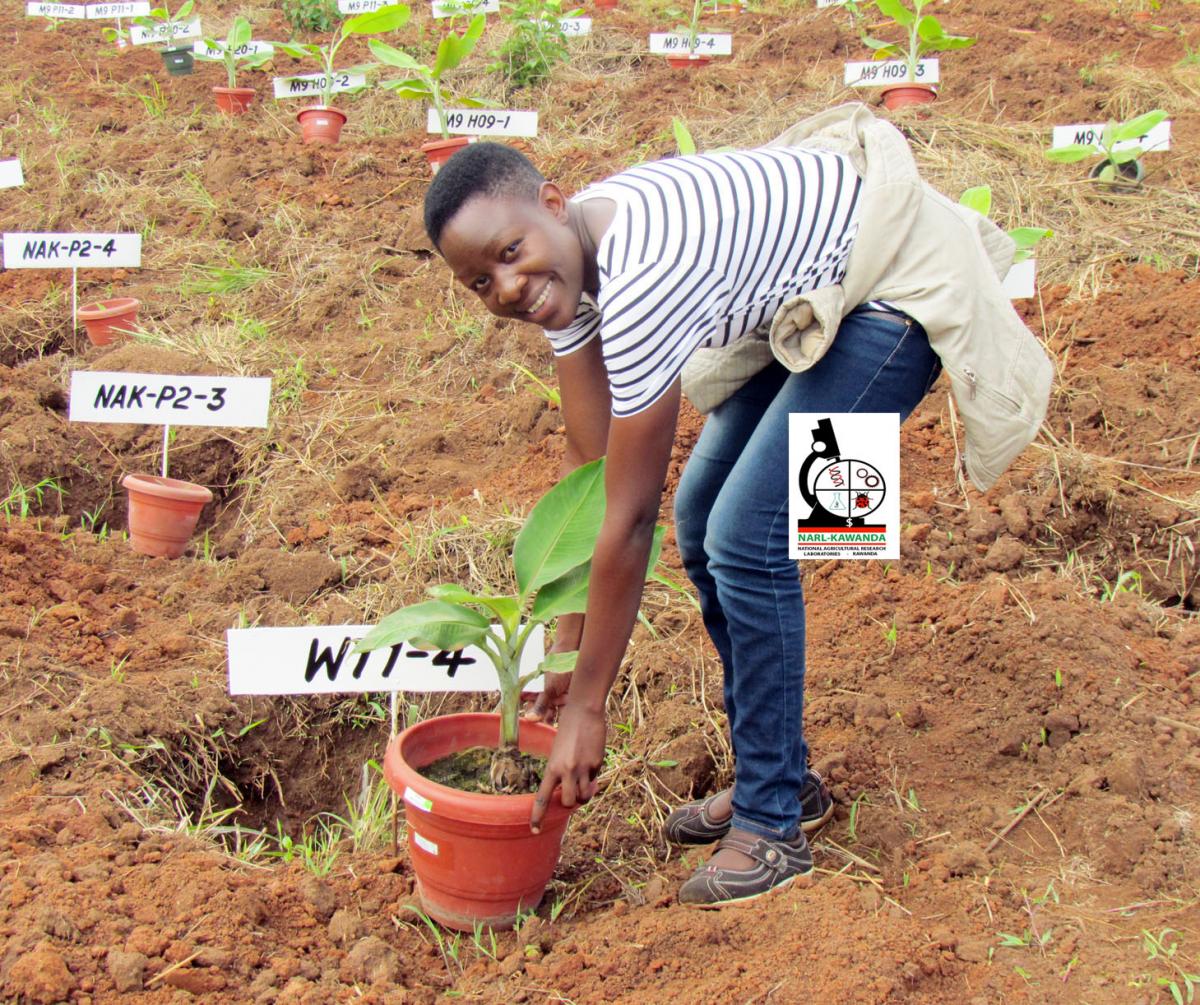
To say that it has been hot in Uganda for the past four or so months is to lie! It has been a furnace temperatures reached a record 37 C. Yes, that is too hot for Uganda, where temperatures have always been a comfortable 26-29 C. The heat wave was obviously caused by delayed rains and this caused untold suffering and starvation due to lack of food.
So it was with baited breath that the National Banana Research Program waited for the ever-elusive rains which eventually showed up in late February. The hoes were swiftly brought out and team members headed far afield to plant the first of three multi-location field trials of the genetically-modified (GM) banana. This banana has been engineered to resist bacterial xanthomonas wilt (BXW). The gene that conferred resistance is from sweet pepper. This field trial, as banana program leader Dr. Jerome Kubiriba says, is the first in the product development phase. We shall plant in two other locations before we select the line to take to the farmers, after the necessary approvals.
For one to understand how dreaded this disease is to the banana crop, and hence farmers, let me narrate a short story. At one of the biotechnology education outreach events, I, as a journalist, struggled to explain to a woman farmer what BXW was. She cut me short and said, I know that disease. We call it silimu we bitooke (HIV AIDS of bananas) in my village. Puzzled I asked her to elaborate on the comparison and she obliged: That disease has no cure. No matter what you do, you still lose the affected banana plants. The only solution we have is prevention ensuring it does not get into our plantations which is difficult.
It is worthwhile to note that currently all banana species, wild and domestic, are susceptible to BXW so there is no source of resistance within the banana genus. That is why scientists had to look elsewhere, specifically sweet pepper, in order to get resistance for BXW. They went head to utilize the tools of biotechnology genetic engineering to transfer that resistance to bananas.
In Uganda, BXW was first discovered in 2001 and spread rapidly throughout the central, southwest and western parts of the country, which are major banana growing areas. At its peak in 2007, the disease had caused the loss of 67 percent of Uganda’s plantations. Through a huge sensitization campaign that saw over six development partners join hands with the National Agricultural Research Organisation (NARO), the disease prevalence has been brought down to 5 percent, as per 2016 data. However, just like the farmers have realized, the cultural methods encouraged during the sensitization campaign are cumbersome and once farmers relax, the disease resurges. Hence the need for a more permanent solution, which genetic engineering is offering.
Sixty lines, which tested 100 percent resistance to BXW during the confined field trial, were planted during the first multi-location trial which was planted at the research station in Kawanda, Kampala. In the other two locations (both research stations), 10 of the best lines will be taken for evaluation, Kubiriba says. It is from these 10 that one will be chosen to go to the farmers.
At this point it s important to note that multi-location trials would ideally be within farming communities, and not at research stations as is normally the case with Uganda. This is because it is currently illegal to grow GM crops in farmer fields, hence the restriction to agricultural research stations. However, this will change the moment the National Biosafety and Biotechnology Bill, from 2012, is signed into law. This is the law that will open farmer access to GM crops in Uganda.

This planting of this multi-location trial is as historic as it is important in the journey to take GM bananas to farmers in Uganda, and later throughout the region. For a GM crop to reach the farmers/consumers, it has to go through phases.
First is the proof of concept phase, where researchers have to prove that the crop can do what they claim it can; in this case, prove that the BXW resistance gene has bee successfully introduced into the East African Highland banana and it actually resists the disease. This phase was completed in 2016 with positive results. Kubiriba says at proof of concept, it was proved that a local banana variety Nakitembe, and a locally preferred hybrid M9, had the gene and along with it, 100 percent resistance to the dreaded bacterial wilt disease.
The second phase is product development. This is the stage at which the science has been proven to work and researchers are testing for performance in different ecological zones. It is also popularly known as multi-location trials. The first multi-location field trial is what happened recently at our research station, the National Agricultural Research Laboratories, located in Kawanda-Kampala. As Kubiriba clarifies, We are going to test how the resistant varieties perform in terms of yield, bacterial wilt resistance, and vigor, in comparison to the ones which are not transformed. From these we shall select 10 lines from which we shall collect data for deregulation. From these 10, we shall select the one line to take to the farmers.
All GM research in Uganda is regulated by the National Council for Science and Technology specifically the National Biosafety Committee (NBC). The NBC chairperson, Dr. Charles Mugoya, and other team members were present at the planting event. As NBC, we are here to ensure that the scientists adhere to the conditions of approval we gave them when they applied to carry out this trial, Mugoya said. However, he also added that he is confident that NARO has the facilities and the personnel for carrying the research and managing the trial.
Uganda is the highest consumer of bananas in the world at 0.70 kg (1.5 lb) daily per person. Almost 90 percent of the bananas grown are consumed locally.
